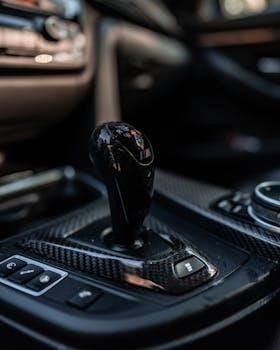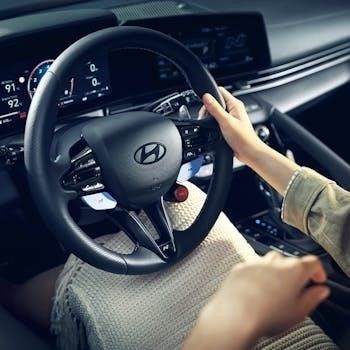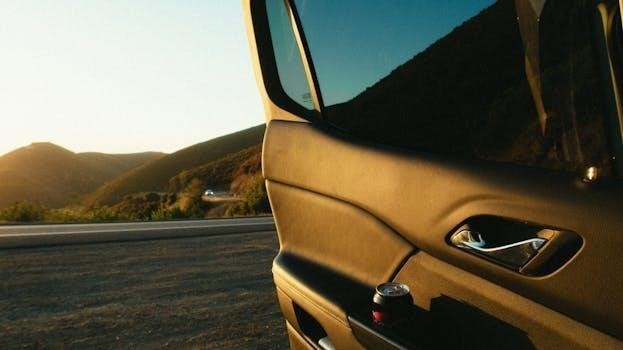Can You Drive a Manual Car with an Automatic License?
No, you cannot drive a manual car if you only hold an automatic license․ Your license restricts you to driving vehicles equipped with automatic transmissions․ Operating a manual car with such a license would be considered an offense․
Understanding License Restrictions
When you obtain a driver’s license by taking your driving test in an automatic vehicle, it comes with a specific restriction․ This restriction legally limits you to operating only automatic and semi-automatic vehicles․ Essentially, you are permitted to drive any car that doesn’t require manual clutch operation․ This is crucial to understand, as driving a manual car with an automatic-only license is against the law, and there may be consequences․ This restriction is in place because the skills and knowledge demonstrated during the automatic driving test do not fully encompass the competencies required to safely operate a manual transmission vehicle․
Automatic vs․ Manual Licenses⁚ Key Differences
The core difference lies in vehicle operation․ A manual license permits driving both manual and automatic cars, while an automatic license restricts you to automatics only․ This impacts flexibility and vehicle choice․
Driving Privileges
A manual license grants broader driving privileges, allowing operation of both manual and automatic transmission vehicles․ This provides more flexibility and options when choosing a car․ An automatic license, however, limits driving privileges solely to vehicles without a clutch pedal requiring manual operation․ Those holding an automatic license are prohibited from driving manual vehicles, as it would be considered a violation of their license restrictions․ This limitation affects the range of vehicles accessible and requires an upgrade to a manual license for those wishing to drive stick-shift cars․ Understanding these distinctions is vital for legal and safe driving․
Flexibility and Vehicle Range
Possessing a manual license unlocks greater flexibility and access to a wider vehicle range․ Drivers with manual licenses can operate both manual and automatic cars, offering more choices when purchasing or renting vehicles․ Conversely, an automatic license restricts drivers to only vehicles without a manual clutch, limiting their options․ Many older and some newer models are only available with manual transmissions, making a manual license beneficial for those seeking diverse car options․ This flexibility also extends to potential job opportunities, as some positions may require the ability to drive manual vehicles․ Therefore, a manual license provides increased versatility․

The Legality of Driving Manual with Automatic License
Driving a manual car with only an automatic license is illegal; Your driving permit specifies the type of vehicles you’re authorized to operate, and violating these restrictions can lead to penalties․
Consequences of Violating Restrictions
Operating a manual transmission vehicle with an automatic-only license carries significant legal ramifications․ If caught, drivers face potential fines, which can vary based on jurisdiction and the severity of the infraction․ Furthermore, driving without the proper license can lead to points being added to your driving record, potentially impacting insurance rates and future driving privileges․ In some instances, the vehicle may be impounded, adding further expense and inconvenience․ Repeat offenses may result in more severe penalties, including suspension of your driver’s license or even jail time․ It is crucial to understand and adhere to your license restrictions to avoid these serious consequences and maintain your legal driving status․
Upgrading from Automatic to Manual License
If you hold an automatic license and wish to drive manual vehicles, you’ll need to upgrade․ This typically involves meeting eligibility requirements and passing a practical driving test in a manual car to demonstrate competency․
Eligibility Requirements
To be eligible to upgrade from an automatic to a manual license, you must first hold a valid, unrestricted automatic driver’s license․ The specific category may vary depending on your location, but generally, it’s a standard passenger vehicle license․
Additionally, you’ll need to meet the minimum age requirement set by your local licensing authority․ Before scheduling your practical driving test in a manual vehicle, ensure all required documents are gathered, including proof of identity, residency, and your current automatic license․ Meeting these requirements ensures a smooth upgrade process․
The Upgrade Process
The upgrade process from an automatic to a manual license typically involves several key steps․ First, familiarize yourself with manual driving through lessons with a qualified instructor․ Once comfortable, you’ll need to book a practical driving test in a manual vehicle․
This test will assess your ability to safely operate a manual car, including gear changes, clutch control, and overall vehicle handling․ Upon successfully passing the test, you’ll receive an updated license that removes the automatic restriction, allowing you to drive both manual and automatic vehicles․

Steps to Obtain a Manual License After Having an Automatic
To obtain a manual license after holding an automatic one, you must first acquire a learner’s permit for manual vehicles․ Following this, you’ll need to pass a practical driving test in a manual car․
Learner’s Permit Requirements
To begin the process of upgrading from an automatic to a manual license, obtaining a learner’s permit is a crucial first step․ This permit allows you to practice driving a manual vehicle under supervision, preparing you for the practical driving test․ The requirements for a learner’s permit typically include being at least a certain age, usually 17 or 18, and passing a vision test․
You will also need to pass a knowledge test covering road rules and safe driving practices specific to manual transmissions․ Ensure you have all necessary documentation, such as proof of identity and residency, before applying․ Once you have your learner’s permit, you can begin practicing your manual driving skills with a qualified instructor or a licensed driver who meets specific requirements, such as holding a full manual license for a certain number of years․
Practical Driving Test
The practical driving test is the final hurdle to upgrading your license from automatic to manual․ This test assesses your ability to safely and competently operate a manual vehicle in real-world driving conditions․ You will be evaluated on various aspects, including clutch control, gear changes, steering, and adherence to traffic laws․
The examiner will assess your ability to perform maneuvers such as hill starts, parking, and navigating intersections․ It’s crucial to demonstrate smooth and confident gear changes, proper use of the clutch, and awareness of your surroundings․ Practice extensively with a qualified instructor to master these skills and familiarize yourself with the test routes․ Successfully passing this test will grant you a full manual license, allowing you to drive a wider range of vehicles․

Learning to Drive Manual After Having an Automatic License
Transitioning to a manual car after holding an automatic license requires practice and patience․ You’ll need to relearn clutch control and gear shifting․ Supervised practice with L plates is essential for developing the necessary skills․
Displaying L Plates
When learning to drive a manual car after already possessing an automatic license, displaying ‘L’ plates is mandatory․ These plates must be clearly visible on the front and rear of the vehicle, just as when you were a new learner․ This indicates to other drivers that you are still in the learning process with a manual transmission, even though you already hold a driving license․
Displaying ‘L’ plates alerts other road users to exercise extra caution and patience around your vehicle․ This is particularly important as you adjust to the intricacies of manual gear changes, clutch control, and coordinating these actions while driving․ Remember to adhere to all learner driver regulations while practicing․
Supervision Requirements
While learning to drive a manual car with an existing automatic license, specific supervision requirements must be met․ You must be accompanied by a qualified supervising driver․ This individual needs to be over 21 years old and hold a full, unrestricted manual driving license from the EU or a designated country for a minimum of three years․
The supervising driver’s role is to provide guidance and ensure your safety as you learn the skills necessary for operating a manual vehicle․ They should be experienced and capable of offering clear instructions, correcting errors, and intervening if needed to prevent accidents․ Their presence is crucial during your practice sessions․

Combined Driver’s License Training
Combined driver’s license training allows individuals to obtain a manual license even after training primarily in an automatic vehicle․ The key number B197 facilitates this, providing a pathway to unrestricted driving privileges․
B197 Key Number
The B197 key number is a specific code added to a driver’s license that signifies completion of combined training․ This allows drivers who initially learned in an automatic vehicle to legally operate manual transmission vehicles․ It bridges the gap between automatic-only licenses and full manual licenses․ This option offers flexibility for individuals who may have initially chosen automatic training for ease or accessibility but later desire the ability to drive manual cars․ The B197 designation confirms the driver has demonstrated the necessary skills and competence to safely operate both automatic and manual vehicles, expanding their driving privileges․ This combined training approach is becoming increasingly popular․
Impact of Electric Vehicles on Driving Licenses
Electric vehicles, with their automatic transmissions, are influencing driving license trends․ As electric car adoption grows, more individuals may opt for automatic licenses, aligning with the transmission type prevalent in electric vehicles, soon becoming compulsory!
Automatic Transmissions and Electric Cars
Electric cars predominantly feature automatic transmissions, eliminating the need for manual gear changes․ This characteristic is reshaping driver training and licensing․ As electric vehicles gain popularity, more drivers are learning to drive and testing in automatics․ This shift could lead to an increase in drivers holding automatic-only licenses․ The rise of EVs might reduce the demand for manual driving skills․ Consequently, future generations may find less need to obtain a manual driving license, impacting the relevance and prevalence of manual driving skills overall as automatic cars are on the rise․ This is a fundamental change in the culture of driving․
Transferring Interstate Driver’s License
In Western Australia (WA), you can transfer an interstate driver’s license for any vehicle class without a practical driving assessment․ However, specific conditions might apply regarding manual licenses if your original license has restrictions․
WA Driver’s License
If you hold a C-A driver’s license and wish to operate a manual car in Western Australia, a C-class manual license upgrade is necessary․ This upgrade ensures you are legally permitted to drive vehicles with manual transmissions within WA․ To be eligible, you must be at least 17 years old․ The upgrade process involves completing the required application and meeting the standard to pass and upgrade to a manual license․ You may be required to do another assessment․ Transferring an interstate license might not automatically grant manual driving privileges if your original license was restricted to automatic vehicles․ Check the WA regulations․